Modeling the Influence of Public Risk Perceptions on the Adoption of Green Stormwater Infrastructure: An Application of Bayesian Belief Networks Versus Logistic Regressions on a Statewide Survey of Households in Vermont
Abstract
:1. Introduction
1.1. Public Perception of Environmental Issues and Pro-Environmental Behavior
1.2. Adoption of Green Stormwater Infrastructure (GSI)
1.3. Bayesian Belief Networks and Application in Research of Environmental Behavior
1.4. Using Bayesian Belief Network to Understand Stormwater Risk Perception and Adoption of GSI
2. Materials and Methods
2.1. Methods and Survey Data
2.2. Comparison with Logistic Regression Models
- Respondents having higher household incomes are more likely to adopt GSI.
- Older respondents (>40 years) are more likely to adopt GSI.
- Respondents living in single-family houses are more likely to adopt GSI compared to other types of residence.
- Respondents who have larger land parcels are more likely to adopt GSI.
- Compared to renters, respondents who own their properties are more likely to adopt GSI.
- Respondents who perceive stormwater-related risks in their neighborhood are more likely to adopt GSI.
3. Results
3.1. Comparison of BBN and Logistic Regression Models
3.2. Unsupervised Learning on Currently Adopted Green Stormwater Infrastructures
3.3. Supervised Learning
3.3.1. Roof Diversion
3.3.2. Rain Gardens
3.3.3. Permeable Pavement
3.3.4. Infiltration Trenches
3.3.5. Constructed Wetland
3.3.6. Influence of independent variables on all types of GSIs
4. Discussion
4.1. Influential Factors Vary for Different Types of GSI
4.2. Risk Perception of Stormwater Issues is Related to the Adoption of GSIs
4.3. Responsibility Attribution Differs Depending on the Type of Stormwater Issue
4.4. Bayesian Belief Network vs. Logistic Regression
5. Conclusions
Author Contributions
Funding
Acknowledgments
Conflicts of Interest
Appendix A. Survey Questions Included in This Study and Variable Type
| Number | Content | Variable Type |
|---|---|---|
| Q1 | Where does the majority of your stormwater runoff go immediately after it leaves your property? | Discrete |
| Q3 | Do you think stormwater runoff is a problem in your neighborhood? | Discrete |
| Q4 | Do you think flooding is a problem in your neighborhood? | Discrete |
| Q5 | In the past 3 years, which if any of the following problems have you experienced at your primary residence? | Discrete |
| Q6 | If stormwater is a problem in your neighborhood, who do you think has the responsibility for fixing the problem? | Discrete |
| Q7 | What type of primary residence do you have? | Discrete |
| Q8 | Do you own or rent your primary residence? | Discrete |
| Q9 | What is the lot size of your primary residence? | Discrete |
| Q10 | Around what proportion of your lot area is built? | Discrete |
| Q11 | Do you make the decisions about your landscape and property management? | Discrete |
| Q12 | What is your usage of compost on your property? | Discrete |
| Q13 | What is your usage of fertilizer on your property? | Discrete |
| Q14 | Which, if any, of the following practices are currently implemented at your primary residence (adopted and maintained)? | Discrete |
| Q24 | What is your gender? | Discrete |
| Q25 | What year were you born? (Age) | Continuous |
| Q26 | What is the highest level of education you have completed? | Discrete |
| Q27 | What is your household income? | Discrete |
| County | Which county the respondent resides in? | Discrete |
Appendix B. MDL Scores of Different Types (Combinations) of Learning Algorithms
| Algorithm | MDL Score |
|---|---|
| Maximum Spanning Tree | 17,530.253 |
| Maximum Spanning Tree + Taboo | 17,481.523 |
| Taboo (from scratch) | 17,493.183 |
| EQ | 17,470.664 |
| EQ + Taboo | 17,470.664 |
| SopLEQ | 17,493.361 |
| SopLEQ + Taboo | 17,476.293 |
| Taboo Order | 17,457.052 * |
| Taboo Order + Taboo | 17,457.058 |
| Algorithm | MDL Score |
|---|---|
| Q14A Roof Diversion | |
| Naïve Bayes | 17,687.349 |
| Augmented Naïve Bayes | 17,164.171 * |
| Tree Augmented Naïve Bayes | 17,179.782 |
| Q14B Rain Gardens | |
| Naïve Bayes | 17,379.76 |
| Augmented Naïve Bayes | 16,858.536 * |
| Tree Augmented Naïve Bayes | 16,885.656 |
| Q14C Permeable Pavement | |
| Naïve Bayes | 17,469.272 |
| Augmented Naïve Bayes | 16,965.952 * |
| Tree Augmented Naïve Bayes | 16,989.163 |
| Q14D Trenches | |
| Naïve Bayes | 17,579.387 |
| Augmented Naïve Bayes | 17,049.492 * |
| Tree Augmented Naïve Bayes | 17,067.485 |
| Q14E Tree Boxes | |
| Naïve Bayes | 17,254.818 |
| Augmented Naïve Bayes | 16,803.641 * |
| Tree Augmented Naïve Bayes | 16,820.125 |
| Q14F Green Roof | |
| Naïve Bayes | 17,350.022 |
| Augmented Naïve Bayes | 16,872.642 * |
| Tree Augmented Naïve Bayes | 16,890.903 |
| Q14G Wetlands | |
| Naïve Bayes | 17,410.658 |
| Augmented Naïve Bayes | 16,920.558 * |
| Tree Augmented Naïve Bayes | 16,939.009 |
| Q14H Others | |
| Naïve Bayes | 17,333.345 |
| Augmented Naïve Bayes | 16,844.032 * |
| Tree Augmented Naïve Bayes | 16,872.497 |
Appendix C. Model Validation for Supervised Learning Models
| Target Node | Overall Precision | Mean Precision | Overall Reliability | Mean Reliability | R | R2 | RMSE | NRMSE |
|---|---|---|---|---|---|---|---|---|
| Q14. Currently adopted green stormwater infrastructure | ||||||||
| A. Roof Diversion | 67.9376% | 65.2115% | 67.3499% | 66.1839% | 0.4027 | 0.1622 | 0.4482 | 44.8187% |
| B. Rain Gardens | 94.9740% | 62.0413% | 93.8476% | 78.6416% | 0.4964 | 0.2464 | 0.1999 | 19.9854% |
| C. Permeable Pavement | 89.4281% | 64.6357% | 87.9872% | 70.6589% | 0.4059 | 0.1647 | 0.2885 | 28.8502% |
| D. Infiltration Trenches | 77.6430% | 62.8419% | 76.2288% | 64.8821% | 0.3861 | 0.1491 | 0.3838 | 38.3809% |
| E. Tree Boxes | 100.0000% | 100.0000% | 100.0000% | 100.0000% | 1.0000 | 1.0000 | 0.0000 | 0.0000% |
| F. Green Roof | 100.0000% | 100.0000% | 100.0000% | 100.0000% | 0.9883 | 0.9768 | 0.0122 | 1.2164% |
| G. Constructed Wetland | 95.6672% | 59.5471% | 94.4591% | 73.2363% | 0.4362 | 0.1903 | 0.1854 | 18.5361% |
| F. Other | 89.9480% | 61.0076% | 88.4242% | 65.7106% | 0.3752 | 0.1408 | 0.2750 | 27.4988% |
| Target Node | Overall Precision | Mean Precision | Overall Reliability | Mean Reliability | R | R2 | RMSE | NRMSE |
|---|---|---|---|---|---|---|---|---|
| Q14. Currently adopted green stormwater infrastructure | ||||||||
| A. Roof Diversion | 55.2860% | 52.2284% | 54.4568% | 52.3320% | 0.0507 | 0.0026 | 0.5283 | 52.8326% |
| B. Rain Gardens | 92.8943% | 50.6451% | 89.7850% | 51.8069% | 0.0284 | 0.0008 | 0.2530 | 25.3033% |
| C. Permeable Pavement | 84.0555% | 49.1151% | 80.9469% | 48.6598% | 0.0814 | 0.0066 | 0.3445 | 34.4458% |
| D. Infiltration Trenches | 73.1369% | 54.4666% | 70.4181% | 55.6399% | 0.1100 | 0.0121 | 0.4450 | 44.4990% |
| E. Tree Boxes | 99.8267% | 50.0000% | 99.6537% | 49.9133% | −0.0024 | 0.0000 | 0.0417 | 4.1725% |
| F. Green Roof | 99.4801% | 50.0000% | 98.9628% | 49.7400% | −0.0082 | 0.0001 | 0.0721 | 7.2109% |
| G. Constructed Wetland | 94.8007% | 51.4565% | 92.2581% | 55.0376% | −0.0089 | 0.0001 | 0.2352 | 23.5233% |
| F. Other | 87.0017% | 47.6281% | 83.0614% | 45.4710% | −0.0677 | 0.0046 | 0.3385 | 33.8506% |
Appendix D. Significant Predictors of Q14 in Logistic Regression
| Estimate | Std. Error | z value | Pr(>|z|) | |
|---|---|---|---|---|
| Q14A: Currently Adopted Roof Diversion | ||||
| Q1H Other stormwater issues | −1.94043 | 0.78000 | −2.488 | 0.0129 * |
| Q11 Property manager or HOA makes decisions | 3.25958 | 1.42043 | 2.295 | 0.0217 * |
| Q13 Fertilizer used on most land (3) | −1.47744 | 0.70880 | −2.084 | 0.0371 * |
| County Bennington | −1.96944 | 0.89958 | −2.189 | 0.0286 * |
| Q14C: Currently Adopted Permeable Pavement | ||||
| Q12 Used on most land (3) | 2.502 × 100 | 1.118 × 100 | 2.239 | 0.0252 * |
| Age | 5.249 × 10−2 | 2.566 × 10−2 | 2.046 | 0.0408 * |
| Q14D: Currently Adopted Infiltration Trenches | ||||
| Q1C Water goes to storm sewer pipe | −1.940 × 100 | 9.309 × 10−1 | −2.084 | 0.037132 * |
| Q5C Runoff, erosion and washout to house | 1.003 × 100 | 4.428 × 10−1 | 2.264 | 0.023564 * |
| Q12 Compost used on isolated areas (2) | 1.947 × 100 | 5.623 × 10−1 | 3.462 | 0.000535 *** |
| Q12 Compost used on most land (3) | 2.182 × 100 | 9.350 × 10−1 | 2.333 | 0.019633 * |
| Q27(2)$10,000–$14,999 | −5.840 × 100 | 2.461 × 100 | −2.373 | 0.017649 * |
| Q27(3)$15,000–$24,999 | −4.428 × 100 | 1.833 × 100 | −2.415 | 0.015719 * |
| Q27(4)$25,000–$34,999 | −5.277 × 100 | 1.863 × 100 | −2.833 | 0.004615 ** |
| Q27(5)$35,000–$49,999 | −5.323 × 100 | 1.816 × 100 | −2.931 | 0.003375 ** |
| Q27(6)$50,000–$74,999 | −4.144 × 100 | 1.758 × 100 | −2.357 | 0.018412 * |
| Q27(7)$75,000–$99,999 | −4.482 × 100 | 1.814 × 100 | −2.470 | 0.013513 * |
| Q27(8)$100,000–$149,999 | −4.707 × 100 | 1.782 × 100 | −2.641 | 0.008260 ** |
| Q27(9)$150,000–$199,999 | −5.358 × 100 | 1.892 × 100 | −2.832 | 0.004631 ** |
| Q27(10) ≥ $200,000 | −4.755 × 100 | 1.939 × 100 | −2.452 | 0.014192 * |
References
- White, M.J.; Hunter, L.M. Public perception of environmental issues in a developing setting: Environmental concern in coastal Ghana. Soc. Sci. Q. 2009, 9, 960–982. [Google Scholar] [CrossRef] [Green Version]
- Marquart-Pyatt, S.T. Concern for the environment among general publics: A cross-national study. Soc. Nat. Resour. 2007, 20, 883–898. [Google Scholar] [CrossRef]
- O’Connor, R.E.; Bard, R.J.; Fisher, A. Risk perceptions, general environmental beliefs, and willingness to address climate change. Risk Anal. 1999, 19, 461–471. [Google Scholar] [CrossRef]
- Bubeck, P.; Botzen, W.J.W.; Aerts, J.C.J.H. A review of risk perceptions and other factors that influence flood mitigation behavior. Risk Anal. 2012, 32, 1481–1495. [Google Scholar] [CrossRef] [Green Version]
- Hines, J.M.; Hungerford, H.R.; Tomera, A.N. Analysis and synthesis of research on responsible. J. Environ. Educ. 1987, 18, 1–8. [Google Scholar] [CrossRef]
- Carlet, F. Understanding attitudes toward adoption of green infrastructure: A case study of U.S. municipal officials. Environ. Sci. Policy 2015, 51, 65–76. [Google Scholar] [CrossRef]
- Barr, S. Factors influencing environmental attitudes and behaviors. Environ. Behav. 2007, 39, 435–473. [Google Scholar] [CrossRef]
- Kollmuss, A.; Agyeman, J. Mind the gap: Why do people act environmentally and what are the barriers to pro-environmental behavior? Environ. Educ. Res. 2002, 8, 239–260. [Google Scholar] [CrossRef] [Green Version]
- Schahn, J.; Holzer, E. Studies of individual environmental concern: The role of knowledge, gender, and background variables. Environ. Behav. 1990, 22, 767–786. [Google Scholar] [CrossRef]
- Steg, L.; Vlek, C. Encouraging pro-environmental behaviour: An integrative review and research agenda. J. Environ. Psychol. 2009, 29, 309–317. [Google Scholar] [CrossRef]
- Vining, J.; Ebreo, A. Emerging theoretical and methodological perspectives on conservation behavior. In New Handbook of Environmental Psychology; Bechtel, R., Churchman, A., Eds.; Wiley: New York, NY, USA, 2002; pp. 541–558. [Google Scholar]
- Rajecki, D.W. Attitudes: Themes and Advances; Sinauer Associates: Sunderland, MA, USA, 1982. [Google Scholar]
- Fishbein, M.; Ajzen, I. Belief, Attitude, Intention, and Behavior: An Introduction to Theory and Research; Addison-Wesley: Reading, MA, USA, 1977. [Google Scholar]
- Ajzen, I. The theory of planned behavior. Organ. Behav. Hum. Decis. Process. 1991, 50, 179–211. [Google Scholar] [CrossRef]
- Ajzen, I.; Fishbein, M. Understanding Attitudes and Predicting Social Behavior; Prentice-Hall: Upper Saddle River, NJ, USA, 1980. [Google Scholar]
- U.S. Environmental Protection Agency. Green Infrastructure. Available online: https://www.epa.gov/green-infrastructure (accessed on 20 October 2017).
- Hjerpe, E.; Adams, J. Green Stormwater Infrastructure Economics in the Boise Urban Area; Idaho Rivers United: Boise, ID, USA, 2015. [Google Scholar]
- Lucas, W.C.; Sample, D.J. Reducing combined sewer overflows by using outlet controls for Green Stormwater Infrastructure: Case study in Richmond, Virginia. J. Hydrol. 2015, 520, 473–488. [Google Scholar] [CrossRef]
- Vermont Department of Environmental Conservation. Green Stormwater Infrastructure (GSI). Available online: http://dec.vermont.gov/watershed/cwi/green-infrastructure (accessed on 5 April 2018).
- U.S. Environmental Protection Agency. Phosphorus TMDLs for Vermont Segments of Lake Champlain; 2016. Available online: https://www.epa.gov/sites/production/files/2016-06/documents/phosphorus-tmdls-vermont-segments-lake-champlain-jun-17-2016.pdf (accessed on 8 October 2020).
- Nylen, G. Accelerating Cost-Effective Green Stormwater Infrastructure: Learning from Local Implementation. Available online: http://scholarship.law.berkeley.edu/cleepubs/14 (accessed on 12 October 2017).
- Copeland, C. Green Infrastructure and Issues in Managing Urban Stormwater. 2016. Available online: https://fas.org/sgp/crs/misc/R43131.pdf (accessed on 8 October 2020).
- Pearl, J. Bayesian Networks. Department of Statistics, UCLA, 2011. Available online: https://ftp.cs.ucla.edu/pub/stat_ser/R246.pdf (accessed on 8 October 2020).
- Pearl, J. Fusion, propagation, and structuring in belief networks. Artif. Intell. 1986, 29, 241–288. [Google Scholar] [CrossRef] [Green Version]
- Heckerman, D. A Tutorial on Learning with Bayesian Networks. 1995. Available online: https://www.cis.upenn.edu/~mkearns/papers/barbados/heckerman.pdf (accessed on 8 October 2020).
- Stone, J.V. Bayes’ Rule: A Tutorial Introduction to Bayesian Analysis; Sebtel Press: Opole, Poland, 2013. [Google Scholar]
- Uusitalo, L. Advantages and challenges of Bayesian networks in environmental modelling. Ecol. Model. 2007, 203, 312–318. [Google Scholar] [CrossRef]
- Aguilera, P.A.; Fernández, A.; Fernández, R.; Rumí, R.; Salmerón, A. Bayesian networks in environmental modelling. Environ. Modell. Softw. 2012, 26, 1376–1388. [Google Scholar] [CrossRef]
- Laurans, Y.; Mermet, L. Ecosystem services economic valuation, decision-support system or advocacy? Ecosyst. Serv. 2014, 7, 98–105. [Google Scholar] [CrossRef]
- Varis, O.; Kuikka, S. Learning Bayesian decision analysis by doing: Lessons from environmental and natural resources management. Ecol. Model. 1999, 119, 177–195. [Google Scholar] [CrossRef] [Green Version]
- Landuyt, D.; Broekx, S.; D’hondt, R.; Engelen, G. A review of Bayesian belief networks in ecosystem service modelling. Environ. Modell. Softw. 2013, 46, 1–11. [Google Scholar] [CrossRef]
- Cain, J.; Batchelor, C.; Waughray, D. Belief networks: A framework for the participatory development of natural resource management strategies. Environ. Dev. Sustain. 1999, 1, 123–133. [Google Scholar] [CrossRef]
- Castelletti, A.; Soncini-Sessa, R. Bayesian Networks and participatory modelling in water resource management. Environ. Modell. Softw. 2007, 22, 1075–1088. [Google Scholar] [CrossRef]
- Varis, O. Bayesian decision analysis for environmental and resource management. Environ. Modell. Softw. 1997, 12, 177–185. [Google Scholar] [CrossRef]
- Barton, D.N.; Kuikka, S.; Varis, O.; Uusitalo, L.; Henriksen, H.J.; Borsuk, M.; de la Hera, A.; Farmani, R.; Johnson, S.; Linnell, J.D.C. Bayesian networks in environmental and resource management. Integr. Environ. Asses. 2012, 8, 418–429. [Google Scholar] [CrossRef]
- Chan, T.U.; Hart, B.T.; Kennard, M.J.; Pusey, B.J.; Shenton, W.; Douglas, M.M.; Valentine, E.; Patel, S. Bayesian network models for environmental flow decision making in the Daly River, Northern Territory, Australia. River Res. Appl. 2010, 28, 283–301. [Google Scholar] [CrossRef]
- Haines-Young, R. Exploring ecosystem service issues across diverse knowledge domains using Bayesian Belief Networks. Prog. Phys. Geogr. 2011, 35, 681–699. [Google Scholar] [CrossRef]
- Sun, Z.; Müller, D. A framework for modeling payments for ecosystem services with agent-based models, Bayesian belief networks and opinion dynamics models. Environ. Modell. Softw. 2013, 45, 15–28. [Google Scholar] [CrossRef]
- Schwenk, G.; Möser, G. Intention and behavior: A Bayesian meta-analysis with focus on the Ajzen–Fishbein Model in the field of environmental behavior. Qual. Quant. 2009, 43, 743–755. [Google Scholar] [CrossRef]
- Keshavarz, M.; Karami, E. Farmers’ pro-environmental behavior under drought: Application of protection motivation theory. J. Arid. Environ. 2016, 127, 128–136. [Google Scholar] [CrossRef]
- Fenton, N.; Neil, M. Risk Assessment and Decision Analysis with Bayesian Networks; CRC Press: Boca Raton, FL, USA, 2012. [Google Scholar]
- Pourret, O.; Naïm, P.; Marcot, B. Bayesian Networks; John Wiley & Sons: Hoboken, NJ, USA, 2008. [Google Scholar]
- Coleman, S.; Hurley, S.; Rizzo, D.; Koliba, C.; Zia, A. From the household to watershed: A cross-scale analysis of residential intention to adopt green stormwater infrastructure. Landsc. Urban Plan. 2018, 180, 195–206. [Google Scholar] [CrossRef]
- Bayesialab. BayesiaLab User Manual. Available online: https://www.bayesia.com/bayesialab-inference (accessed on 24 October 2018).
- Conrady, S.; Jouffe, L. Bayesian Networks and BayesiaLab: A Practical Introduction for Researchers, 1st ed.; Bayesia: Franklin, TN, USA, 2015. [Google Scholar]
- BayesiaLab User Guide. Available online: https://library.bayesia.com/articles/?__hstc=221168007.37414d9c264ebfa7c9f79fe0dd598c7b.1601391423390.1601391423390.1601391423390.1&__hssc=221168007.2.1601391423391&__hsfp=2043891175#!bayesialab-knowledge-hub/unsupervised-learning-2392576 (accessed on 7 October 2020).

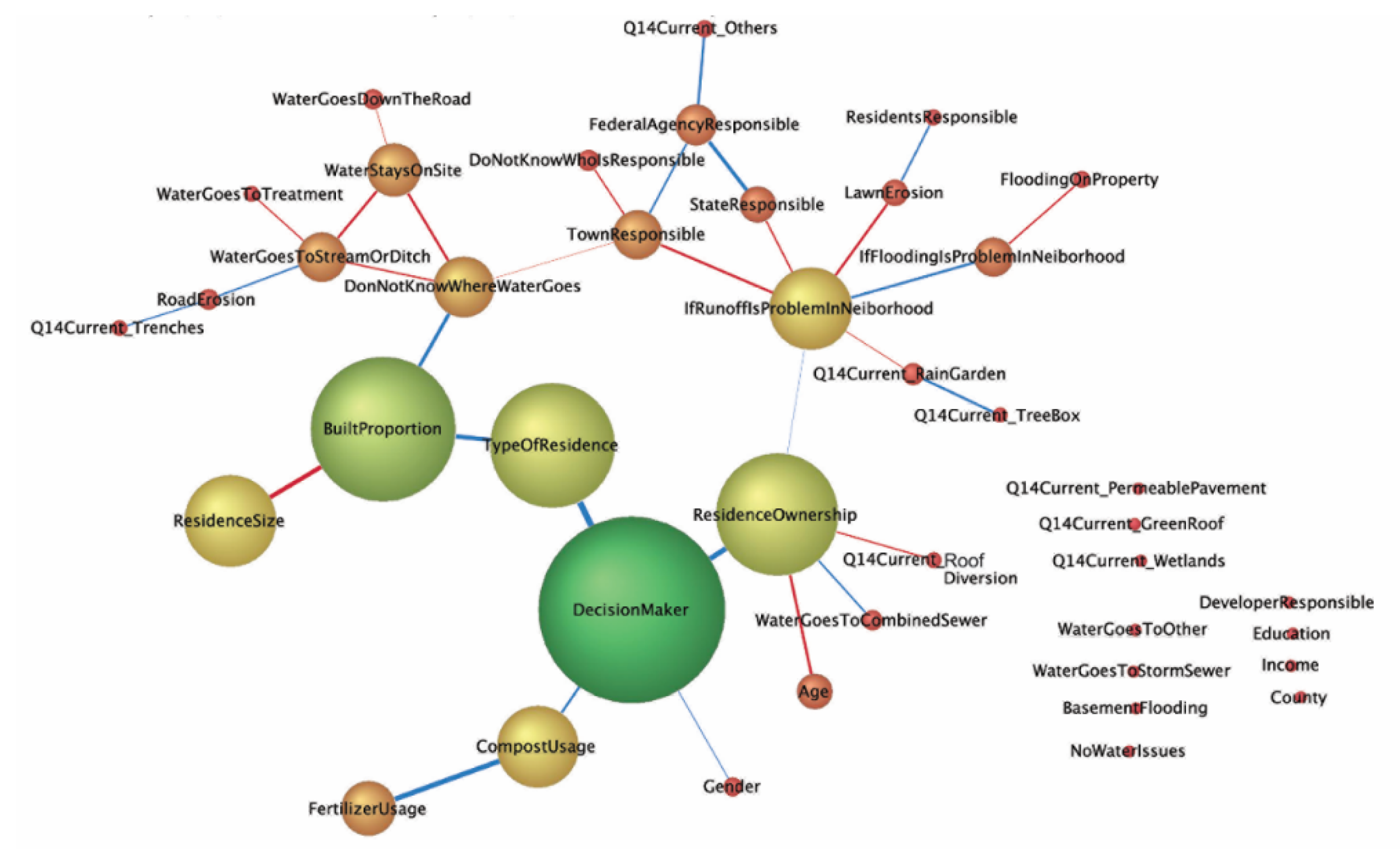
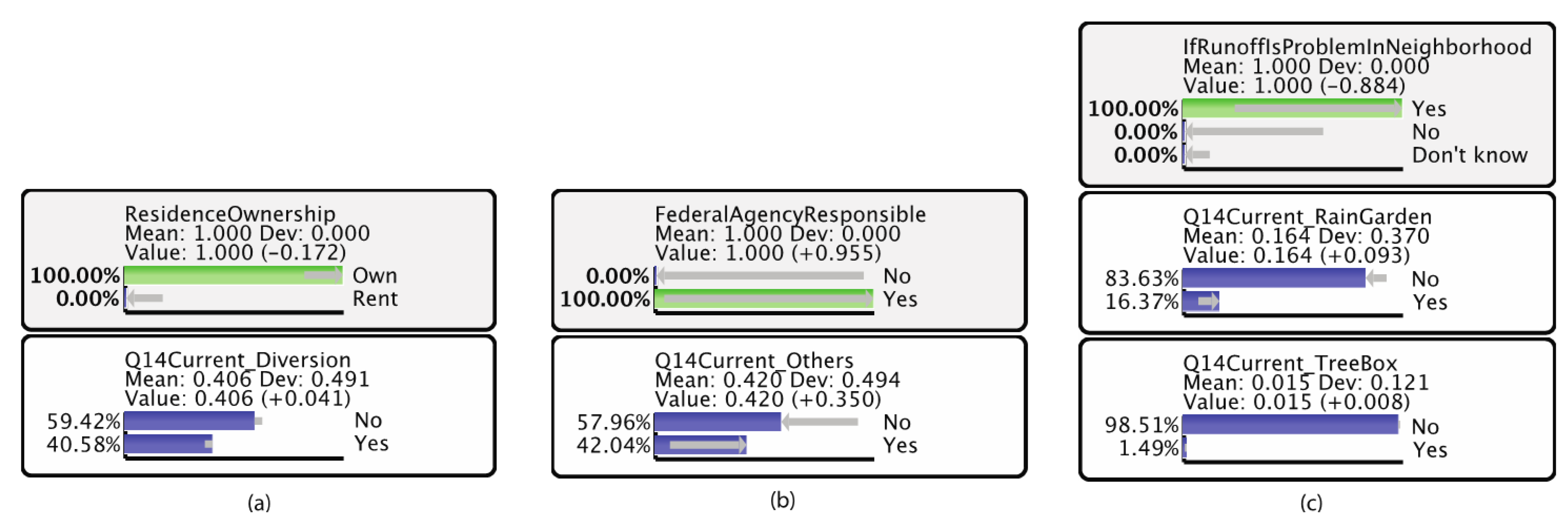
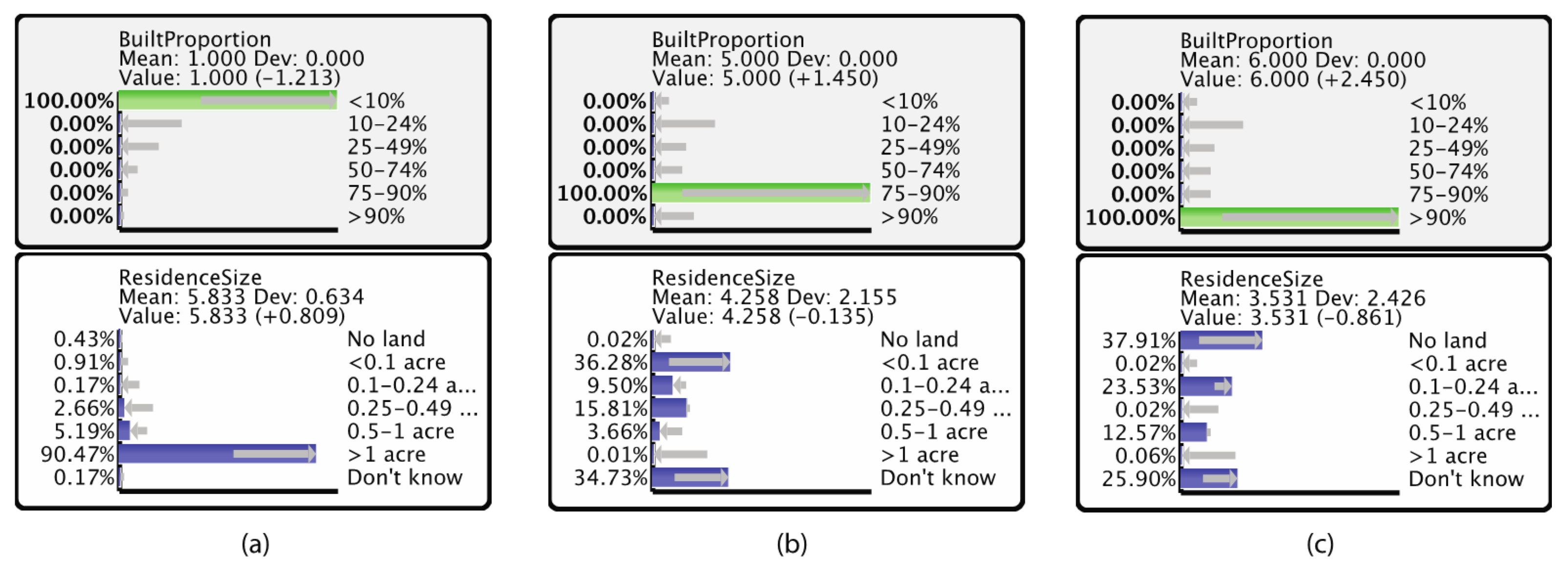
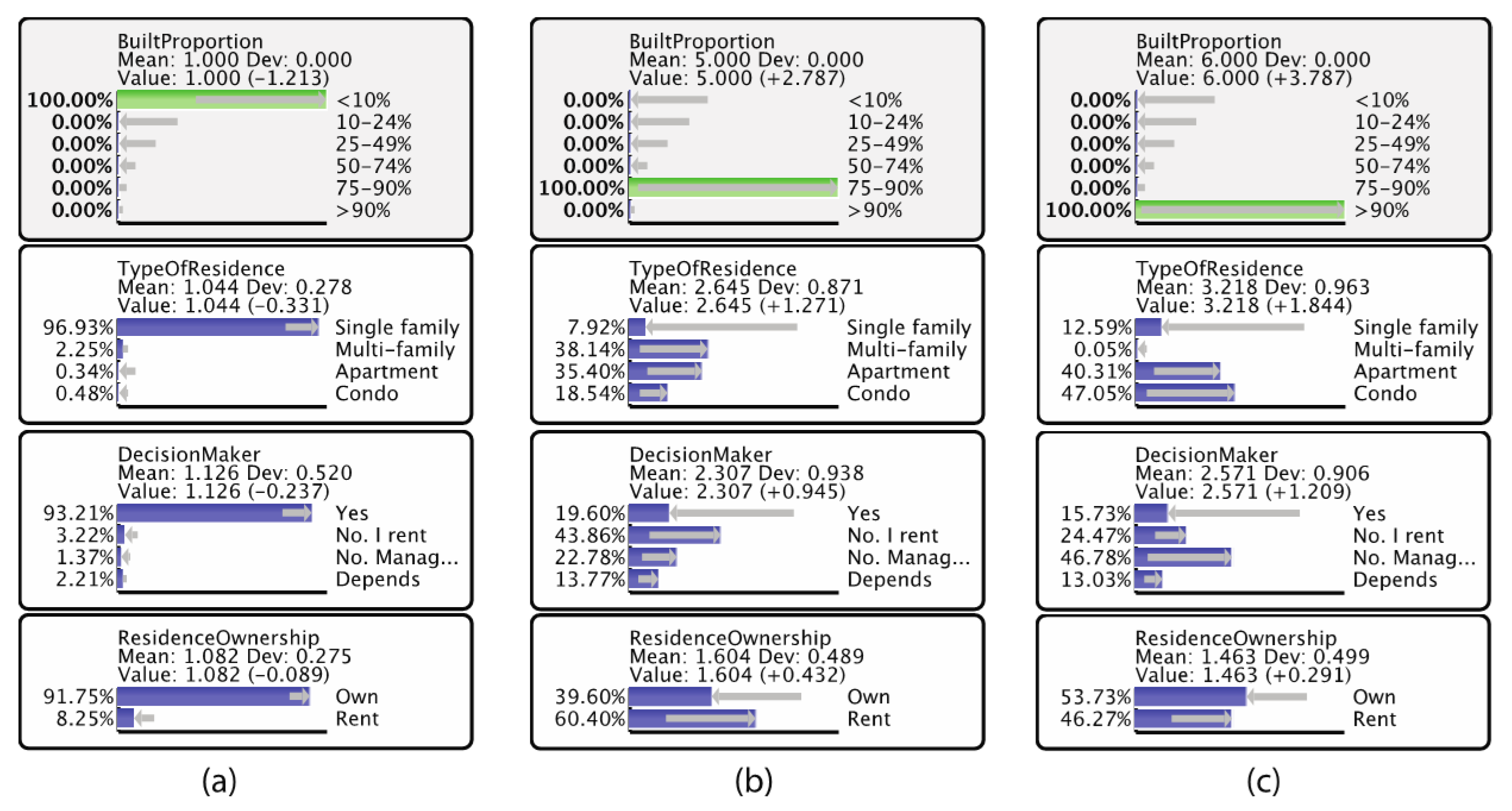

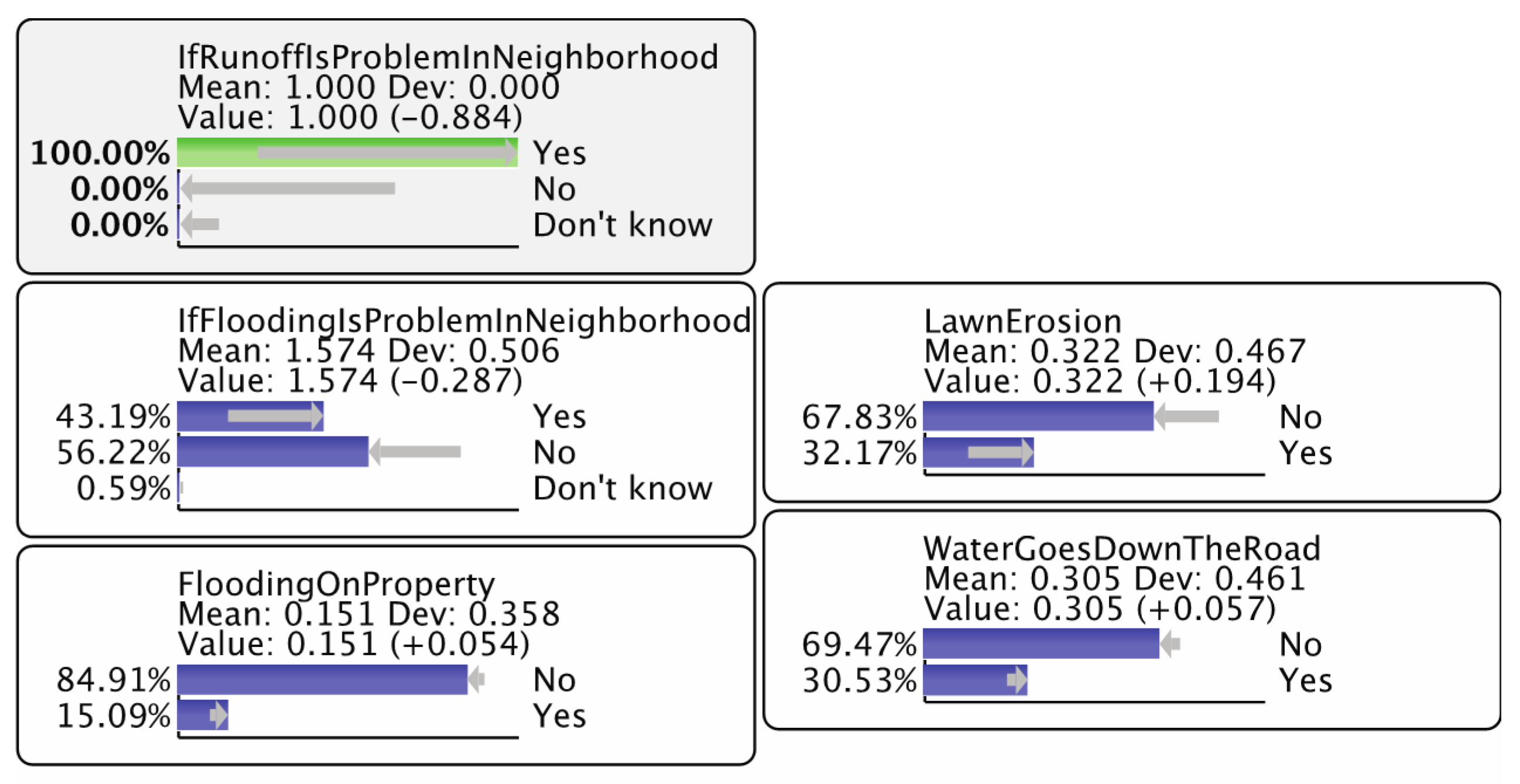
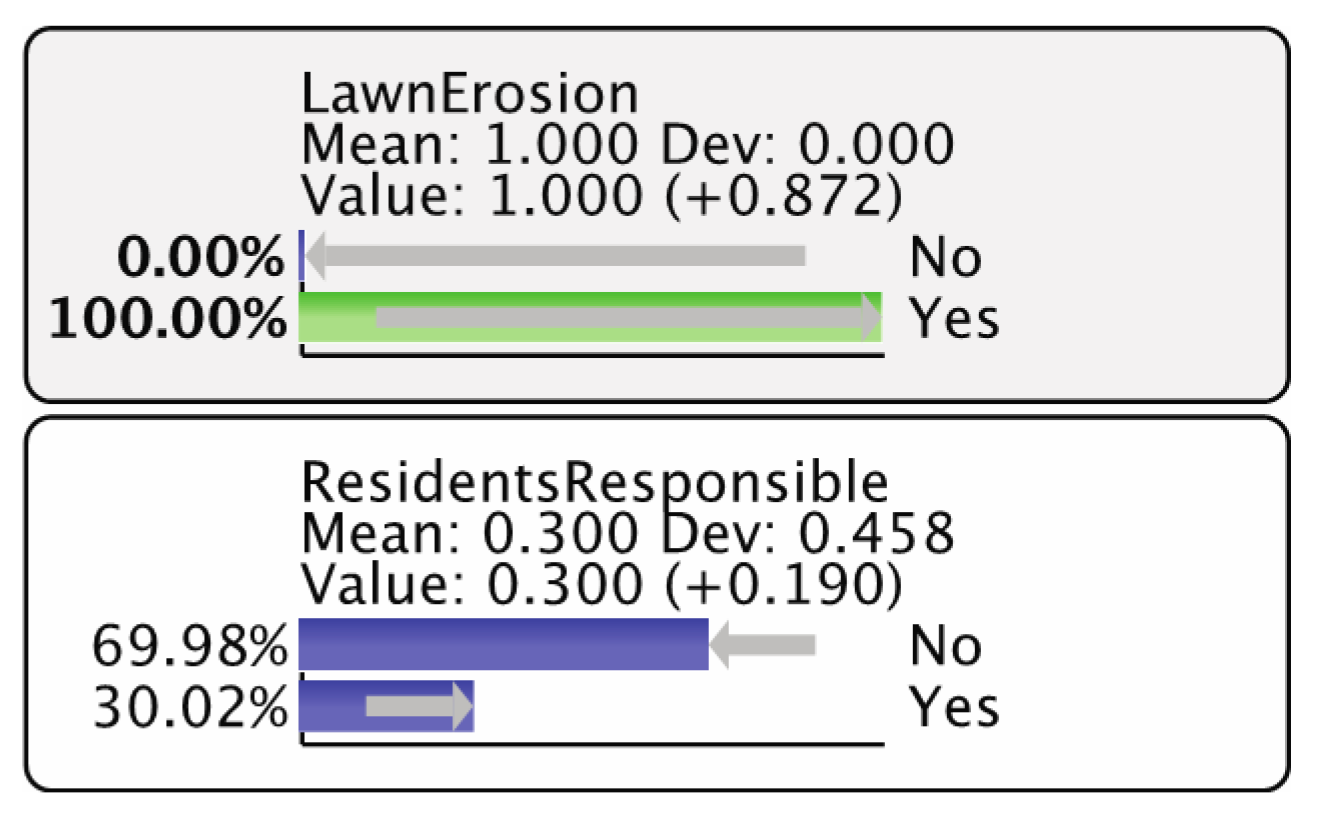
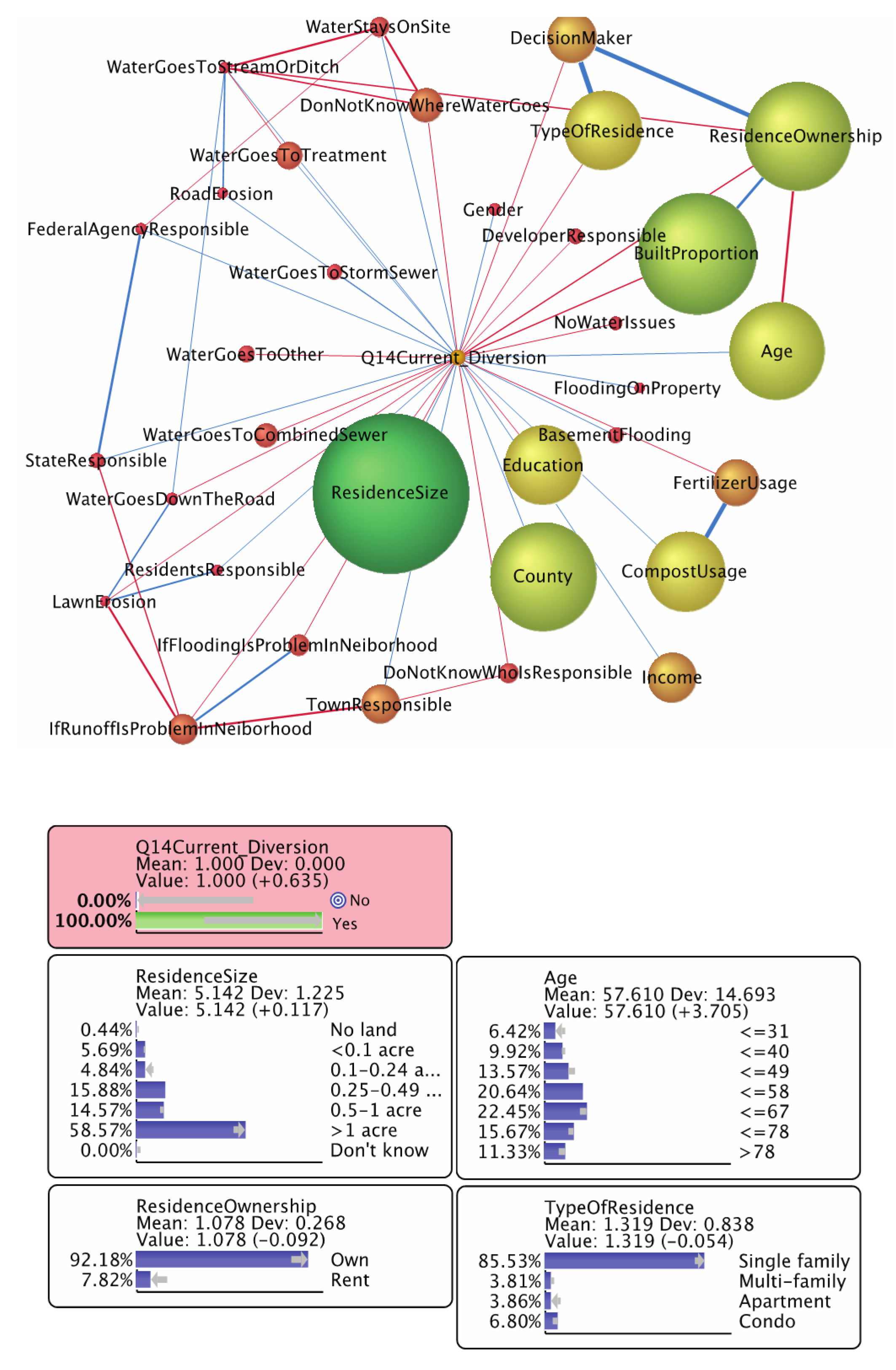
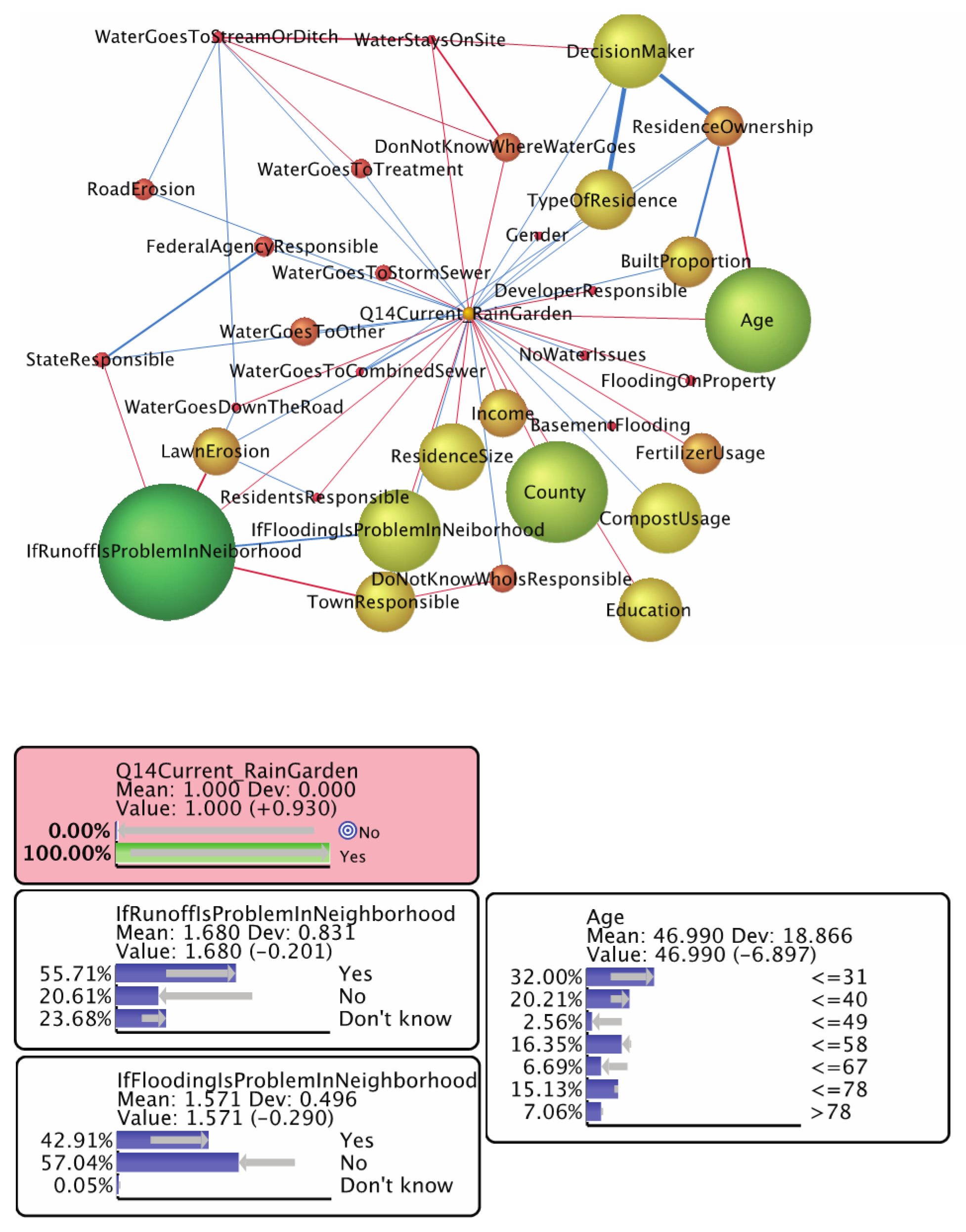
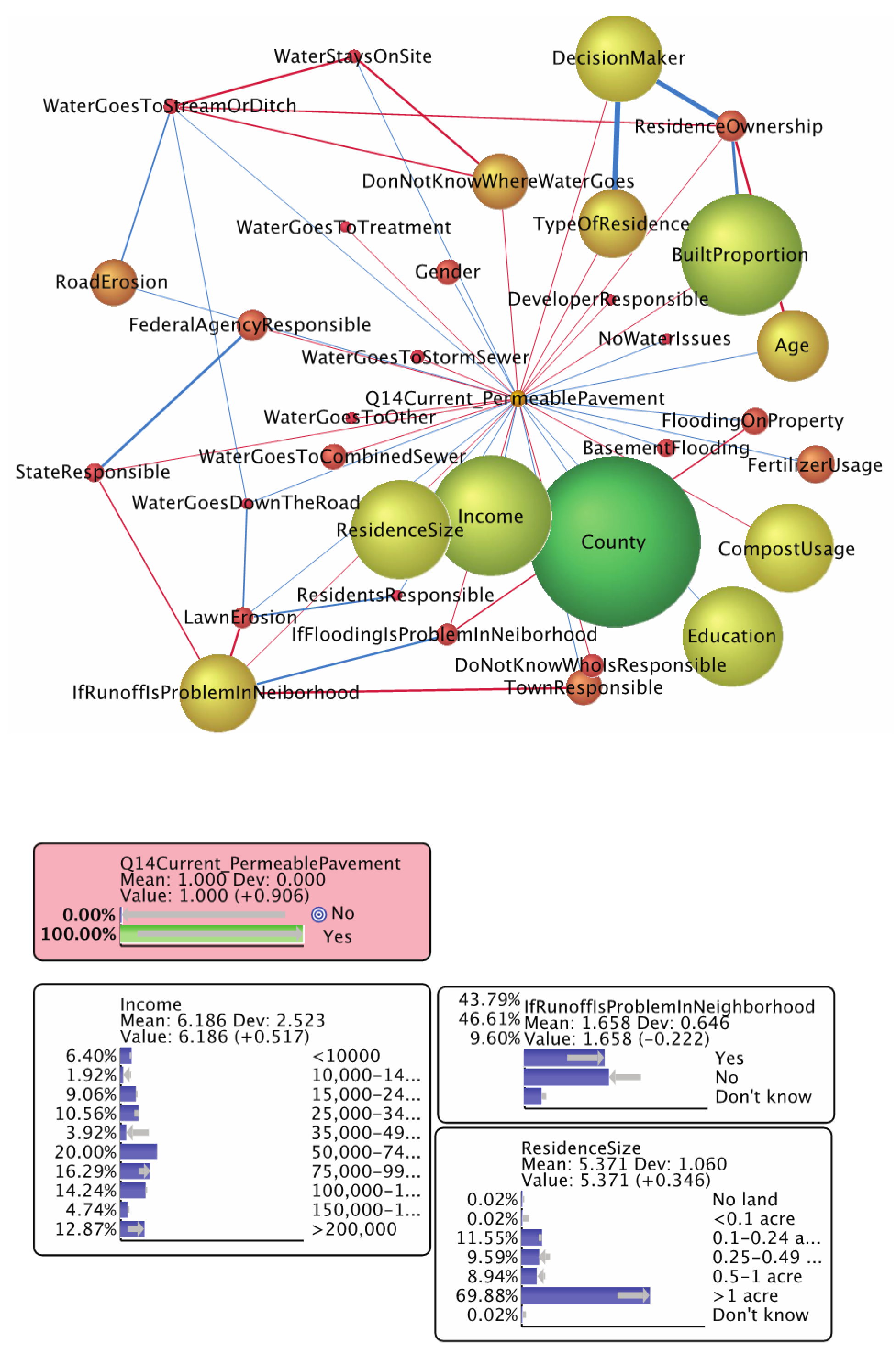

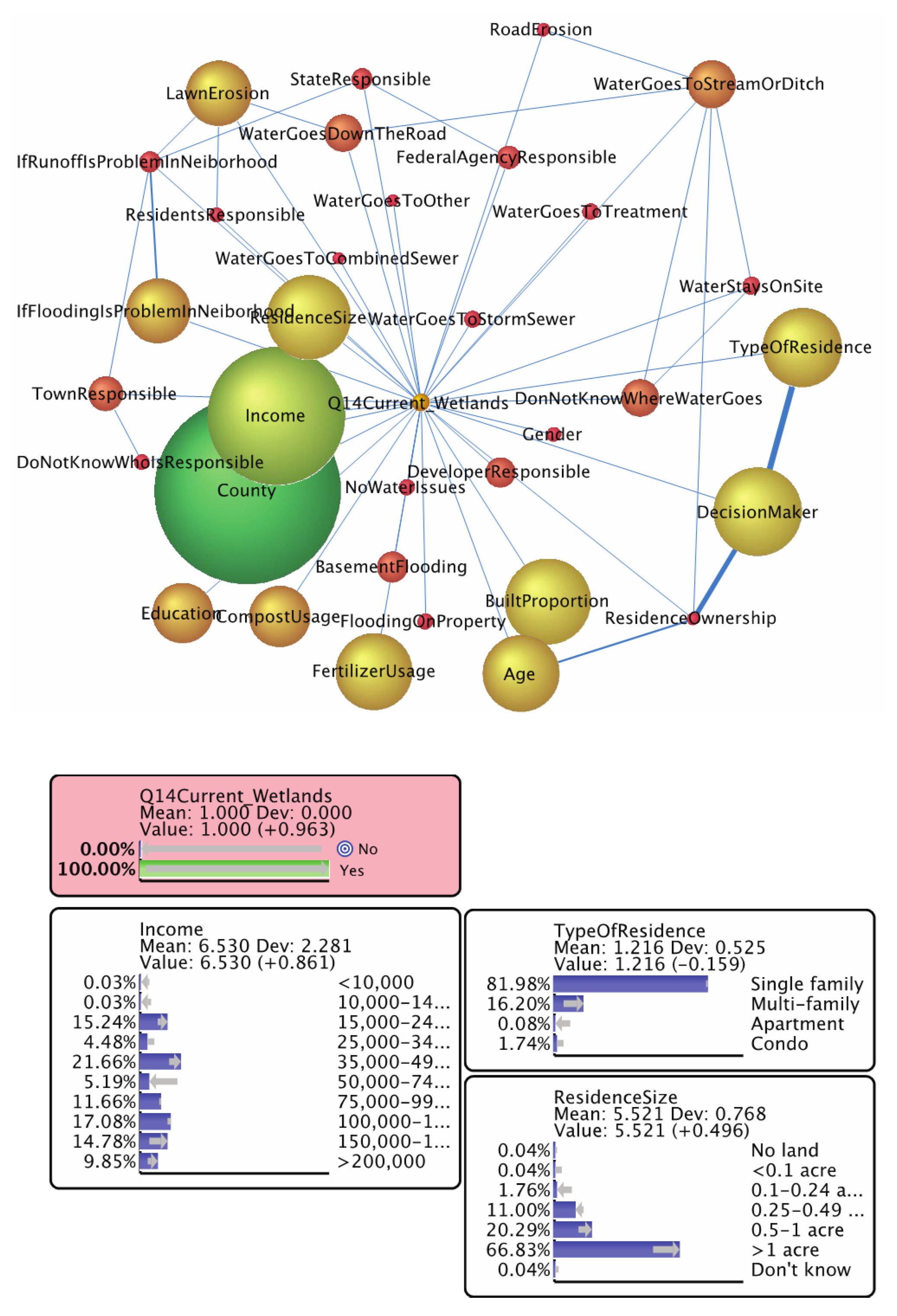
| Target GSI Adoption | |||||
|---|---|---|---|---|---|
| Influential Variables | Roof Diversion | Rain Garden | Permeable Pavement | Infiltration Trenches | Constructed Wetland |
| County | 0.0273 | 0.0317 | 0.0339 | 0.02 | 0.0228 |
| Income | 0.0111 | 0.0135 | 0.0233 | 0.0356 | 0.0165 |
| Age | 0.0241 | 0.0331 | 0.0128 | 0.0106 | 0.0085 |
| Type of residence | 0.0192 | 0.0177 | 0.0124 | 0.006 | 0.0088 |
| Residence size | 0.0412 | 0.02 | 0.0188 | 0.0223 | 0.0095 |
| Residence Ownership | 0.0272 | 0.0108 | 0.0043 | 0.0103 | 0.0001 |
| If runoff is problem in neighborhood | 0.0056 | 0.0435 | 0.0143 | 0.0003 | 0.0012 |
| If flooding is problem in neighborhood | 0.0032 | 0.0252 | 0.0025 | 0.0006 | 0.0069 |
Low score  High score High score | |||||
| Hypothesis | Types of GSI that Supported Hypothesis | Types of GSI that Showed Opposite Pattern to Hypothesis |
|---|---|---|
| Respondents having higher household incomes are more likely to adopt GSIs | infiltration trenches permeable pavement | - |
| Older respondents (>40 years) are more likely to adopt GSIs | roof diversion | rain gardens |
| Respondents living in single-family houses are more likely to adopt GSIs compared to other types of residence | roof diversion | constructed wetlands |
| Respondents who have larger land parcels are more likely to adopt GSIs | roof diversion permeable pavement constructed wetlands | - |
| permeable pavement | ||
| Compared to renters, respondents who own their properties are more likely to adopt GSIs | roof diversion | - |
| Respondents who perceive stormwater-related risks in their neighborhood are more likely to adopt GSIs | rain gardens infiltration trenches | - |
© 2020 by the authors. Licensee MDPI, Basel, Switzerland. This article is an open access article distributed under the terms and conditions of the Creative Commons Attribution (CC BY) license (http://creativecommons.org/licenses/by/4.0/).
Share and Cite
Ren, Q.; Zia, A.; Rizzo, D.M.; Mathews, N. Modeling the Influence of Public Risk Perceptions on the Adoption of Green Stormwater Infrastructure: An Application of Bayesian Belief Networks Versus Logistic Regressions on a Statewide Survey of Households in Vermont. Water 2020, 12, 2793. https://doi.org/10.3390/w12102793
Ren Q, Zia A, Rizzo DM, Mathews N. Modeling the Influence of Public Risk Perceptions on the Adoption of Green Stormwater Infrastructure: An Application of Bayesian Belief Networks Versus Logistic Regressions on a Statewide Survey of Households in Vermont. Water. 2020; 12(10):2793. https://doi.org/10.3390/w12102793
Chicago/Turabian StyleRen, Qing, Asim Zia, Donna M. Rizzo, and Nancy Mathews. 2020. "Modeling the Influence of Public Risk Perceptions on the Adoption of Green Stormwater Infrastructure: An Application of Bayesian Belief Networks Versus Logistic Regressions on a Statewide Survey of Households in Vermont" Water 12, no. 10: 2793. https://doi.org/10.3390/w12102793
APA StyleRen, Q., Zia, A., Rizzo, D. M., & Mathews, N. (2020). Modeling the Influence of Public Risk Perceptions on the Adoption of Green Stormwater Infrastructure: An Application of Bayesian Belief Networks Versus Logistic Regressions on a Statewide Survey of Households in Vermont. Water, 12(10), 2793. https://doi.org/10.3390/w12102793




